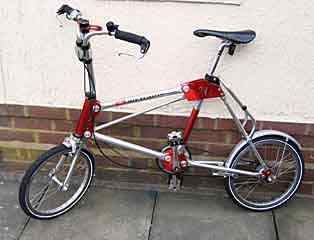
As of now, 24 June 2004, I have been using an Airframe for a few weeks, thanks to a dealer and Silkmead, the manufacturers of the bike, who loaned it to me. This report contains some early impressions based on limited use over that period - I hope to add another report based on further testing if I'm able to keep the bike a bit longer.
The Airframe was originally designed back in the late 1970's by architect Grahame Herbert, and in 1979 it won third prize in the Bike of the Future competition run by the British Cycling Federation. However, it was not until 1984 that it finally went into production, and it even featured in the Freewheel mail order catalogue around that time. The multitude of joints needed for the folding proved rather too much of a challenge for manufacture at the time, and bikes produced at that time gained a reputation for being rather flexible. Not very many of these original examples were manufactured, although some still survive, and are even in regular use.
After being out of production for many years, the design was resurrected a couple of years ago, and appeared at the Islington Bike Show in 2002, and then again in 2003. For the new production, Grahame Herbert involved specialist tube manufacturer Silkmead, and the combination of some detail design changes (though the bike still looks superficially similar to the original) and the new manufacturer promised substantially better performance.
I tried an example in the underground car park at Islington during the Bike Show in 2002, and in that extremely limited test it still felt rather flexible to me, but since then there have been some further changes, and I had the chance to try one again rather briefly during our visit to the National Cycle Collection at Llandrindod Wells last year. Handling was certainly different from most bikes, but I felt that further use might bring familiarity and respect, so when I got the opportunity to borrow one for a few weeks recently, I jumped at the opportunity. A few friends who had tried this same demonstrator were not very enthusiastic, but they are all stronger and heavier riders, with what I will describe, politely, as a more vigorous cycling style, so I reserved judgement. As I have so often stated before on these web pages, choice of a folder is a question both of personal taste and horses for courses, and I have attempted to take this into account in this report - I don't think the Airframe is primarily intended for cycling enthusiasts who want to use it for long tours, or for fast riding. That said, the designer toured the USA with one (public transport assisted), and Denise Wilson rode the bike in a sponsored 400Km charity ride through the Sinai desert, and reportedly rejected offers of a more conventional bike, preferring the Airframe.

The bike I have been using had been a demonstrator for some while before it reached me, but it still looked very smart. There is no paintwork to scratch and chip, and the aluminium frame etc means there is very little to corrode. The silvery aluminium colour of the frame tubes is offset by the small coloured areas - red on this example (purple and blue seem to be the other available colours). While riding it I did not suffer the rude comments that one often gets when riding a small-wheeled folder - it's obviously a folder, but manages to like quite sophisticated and purposeful. The lack of many components which would rust may well make the bike particularly appealing to those who use and store it in damp conditions, eg boats.
Component quality is quite good - there are no signs of cost cutting, and the folding pedals are excellent, locking positively into place both when folded and unfolded. Good plastic mudguards are fitted, with plenty or wrap-around, which should avoid water etc being thrown onto the rider when riding in the rain. I replaced the saddle supplied with a Flite Titanium for the test - few standard saddles are particularly comfortable on longer rides in my experience, though the one supplied in this instance looked quite reasonable, and might also have felt OK if I had given it a try, especially as the distances covered have not been especially high.
The saddle appears to have a good range of height adjustment - as I am short (1.7m, 5'6.5", 66.5") I did not really need to explore this, but there seemed plenty of scope for shorter and taller riders. The handlebars can also be set at one of 3 available fixed heights. The riding position, with these adjustments, and a nice (for me) reach was good - more to my taste than on an older Brompton (I have not yet had a chance to try a Brompton with the new hinge and longer frame, but this will not address the handlebar height issue). I believe the bike is rated for a rider of up to 15 stone (210 pounds, 95Kg). Heights ranging from 5'0" to 6'6" are mentioned in the literature, though how ideal the riding positions are in the extreme cases I'm not sure. I'll comment again later on how the Airframe may suit larger riders.
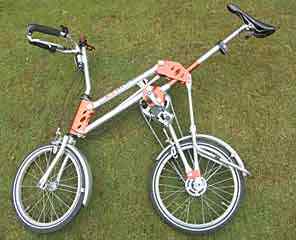
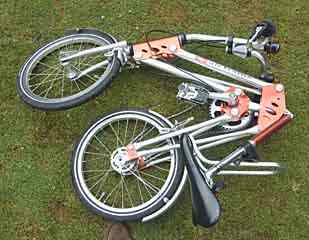
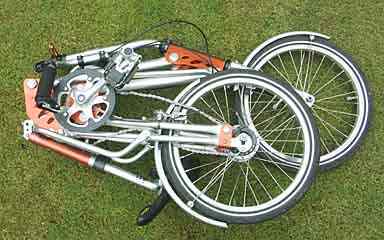
These pictures are intended more to indicate how the fold operates, rather than exactly the steps followed - I'm not sure that the first stage is ever as shown (the front wheel would probably have been turned through 180 degrees slightly before this)
The folding/unfolding process is somewhat reminiscent of an umbrella - the accompanying photographs show the bike in various stages of folding. The end result when folded is fairly long, but quite compact in both other directions. Overall it occupies more space than, for example, a Brompton, when folded, but it is not inconvenient, and in some situations the shape of the folded package may have advantages over a machine like the Brompton. Once folded, the machine locks together and does not have the irritating tendency to unfold itself which many others do (notably NOT the Brompton). It is fairly easy to pick up and carry horizontally, or it can be wheeled along on one of the wheels in a more vertical orientation, though it is slightly difficult to find a convenient point at which to grip it in this mode. A big plus point when carrying it, lifting it or just the basic folding is the relatively light weight - the claimed weight is 10.5Kg (23 pounds), which makes it quite a bit lighter than the Brompton and a lot of other folders. If you need to carry it up stairs, for example, this is quite a bonus.
The actual folding process I found somewhat awkward. No doubt more practice would make me both more confident and more expert, but it did seem a bit difficult to get the sequence of pulling and pushing just right, and the final step of swivelling the seat post around and locking it in place was also rather fiddly. A number of times I got into quite a muddle, and I wouldn't want to try it in a hurry with an audience! The most troublesome bit though was that originally I swivelled the front wheel round anti-clockwise, which meant that unless it was done at just the right time, the end of the brake cable, where it meets the calliper, gets mangled - there was evidence that this had already happened on the demonstrator before I got it. If your rotate the bars/wheel clockwise, there is no problem, but if you have other folders where the direction of rotation when folding is anti-clockwise, it's an easy mistake to make. For me, it is a bike which I won't fold if I don't need to - which is true of every folder I have ever owned or used, with the sole exception of Bromptons. The one time (well, twice actually) that I have folded in anger was when I took my car in for a service - it is a Smart, and the dealer is about 10Km away. The Airframe fitted into the back quite comfortably in its normal folded form - the upper, but not the back, part of the parcel shelf/separator, needed to be folded back on the Smart, but there was no problem with the length of the bike, and it impeded rearward vision less than any other folder I have put in the car, including a Brompton (as it is rear-engined, the boot floor is quite high, and most bikes block the already extremely limited rear view). The Airframe does actually have a quick-release front wheel, to allow it to be removed where there is a need to reduce the size a bit more - I understand this allows it to fit in a Mini (presumably the new BMW ones, not the old ones!) - but it was not necessary to go that far with the Smart.
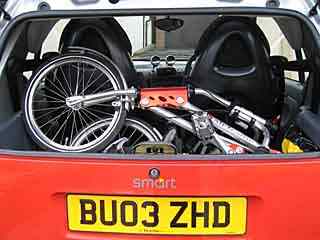
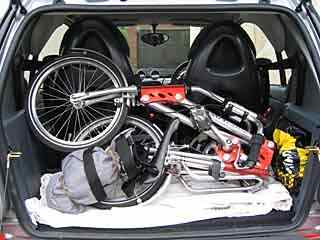
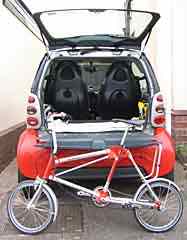
Quite a comfortable fit inside the Smart - if the right-hand picture looks a little odd, I should explain that my drive slopes very steeply, so the wheels of the Airframe are at least 20cm lower than the car.
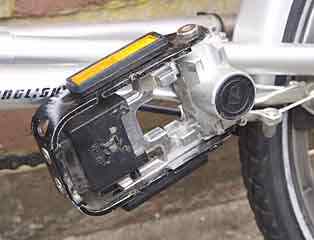
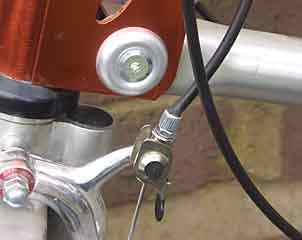
Above Left: Excellent folding pedals - they lock into position both when folded and unfolded. Above Right: If you rotate the front wheel anti-clockwise instead of clockwise when folding, this picture shows how the brake cable will get mangled where it enters the brake callipers
In its folded form, the chain is exposed on one side of the bike, but in practice it is very easy to avoid picking up dirt from it during folding or when carrying the bike without the bag. However, some care will be needed when putting the bike down - it does not stand terribly well on its own, and it would be easy for the chain to deposit grime on an adjacent surface. During and when folded the chain is moderately well controlled and retained (though it did come adrift once when unfolding, and in particular you need to make sure the chain is seated properly on the rear sprocket during the final stage of unfolding), without the need for any form of tensioner (a source of noise, loss of energy, cost, a dirt collector, and source of complication when dealing with rear wheel punctures!).
When folded, the bike does not look as neat as a Brompton, so the possibility of needing to bag it when using some forms of public transport is considerably higher (though no greater than on many other folders). The bag (an optional extra) is an excellent combination of light weight and adequately robust construction. When not in use, it packs quite small, and will go onto the rear carrier. By folding it in on itself, and hanging it on the rear carrier, you have a capacious bag which can be used for carrying shopping, luggage etc. Fitting and removal of the bag is just a case of attaching/detaching two Velcro straps on the saddle and sliding it off the carrier - perhaps not as sophisticated as the Brompton front carrier, but nearly as quick and convenient, and very light.
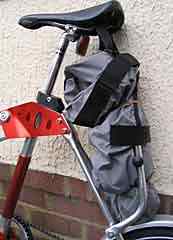
Above: The bag in its most compact form on the rear carrier. It is quite sturdy, but also light
There is another minor fold which I have found exceptionally useful, namely just to fold the handlebars and the pedals. In this form you have a narrow and very stable package - brilliant for parking in hallways, or rooms, where the width becomes minimal, and it is not necessary to reduce the height. With no handlebars sticking out, the space requirement is small, and there are no handlebars to get knocked, resulting in the bike falling over. With the bars turned in, and propped against the wall, the stability is improved further, so that unlike a normal bike, especially a small wheeler, there is little risk of the front wheel turning and the whole bike falling over of its own accord. This mode of fold also makes carrying it through doorways, up stairs, into offices etc quite easy, and may in many situations obviate the need for a full fold. It is also convenient on trains when using cycle spaces - eg on Sprinters, or local trains with a folding seat space for cycles.
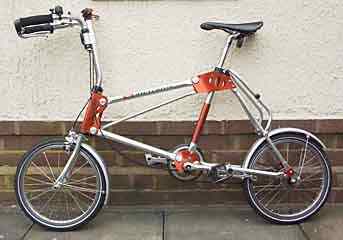
Above - the flat fold - quick, and makes storage in a hallway etc very convenient
The Airframe is fitted with a 4-speed Shimano hub gear, giving gears of about 40, 50, 60 and 74 inches. The range of gears provided by this unit is not actually much different from the 3-speed Sturmey-Archer and Sachs/SRAM units, but the spacing of the gears is closer and more even. I regret that the range is limited, but heartily approve of the spacing - I find the 3-speeds mentioned are all but unusable due to the spacing, which results in pedalling like a maniac in a low gear and then changing up, only to have the knees creak. Whenever I do have to use one of these 3-speeds, my knees know about it next day, and I would not use one regularly for this reason.
Choice of gearing is very personal, but I felt quite strongly that the overall gearing of the Airframe was a bit too high. Top gear is actually not all that high, but the bottom gear of around 40 inches is to my mind rather too high, except in fairly flat country. Though this may to some extent be a personal matter, I think that in the case of the Airframe there is a particular reason to aim for low gearing. The Airframe is a distinctly flexible bike - more on this later - and if you work hard using a high gear, then the frame will flex, which is unpleasant for the rider, results in loss of efficiency, and also cannot be good for the bike. This bike is definitely going to be better if ridden sympathetically, and 'twirling' the pedals rather than slogging in high gear.
Anyway, I tried fitting a larger rear sprocket - 17 teeth in place of the normal 16, lowering the gears to about 37.5, 47, 56.5 and 69.5 inches. This was a fairly small change in gearing, but to my mind it did make a significant improvement. I might even have considered going a bit lower still, but this would have compromised the top gear, and also I found it unexpectedly awkward to effect the change of rear sprocket, as outlined below.
The replacement sprocket for the Shimano hub is the same as used for S-A and SRAM hubs, which made obtaining one fairly easy, except that on this bike it uses a 3/32 chain rather than the more usual 1/8 found with hub gears - St John Street Cycles were able to supply a suitable sprocket. I've never worked on a Shimano hub before, and I found removal of the rear wheel and the gear cable less convenient than on the S-A and SRAM hubs. The instruction book supplied with the bike warns you to make a note of how the cable winds around the hub before you remove it - it would be better if there were a picture as well, because inevitably, although I looked very carefully at how it was fitted, when it came to replacing it I found my recollection not as good as I had hoped. Of course I should have taken a digital photograph! The rear dropouts are slotted front to back, so adjusting the position of the axle to compensate for a different sprocket should be easy. Actually, it isn't, as the securing/locating washer of the Shimano hub makes it impossible to move the axle fore and aft, so changing the sprocket and/or front chain ring may well make it difficult to get a satisfactory chain length. The chain was a bit tight when fitted after the sprocket change (it seemed a bit loose to me before the change), but I found it quite a bit looser later, and consequently had to apply more force on the axle fixing bolts when re-locating it.
Gear change adjustment was not a major problem, as only a minor tweak was necessary while I had the bike. The twist-grip gear control has a knurled adjuster on it, but the amount of adjustment provided here is limited. I would hate to replace the cables, as apart from this limited adjustment, the Shimano system does not seem to provide any means of altering the length of the cable apart from removing the cable at the rear and moving the cable on the clamping device - a process of trial and error which could be very time consuming and frustrating. The cable from the handlebar control passes almost immediately through a hole in the handlebar and out of the bottom of the bars - very neat, and it keeps the cables from flapping about, but in practice it means that the range of adjustment using the knurled adjuster on the control is further limited, and it also means (at least on the test bike) that the twist grip cannot be positioned so that the gear selection indicator is visible to the rider - you need to remember what gear you are in, or use a marker to put some more visible indications on the control!
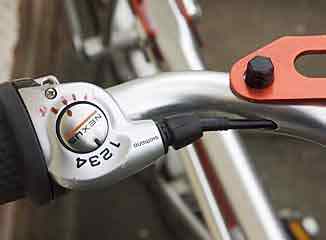
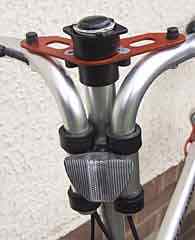
Above Left: Neat routing of the cables through the bars, but it does impede adjustment of the gears, and leaves the gear selection indicator invisible to the rider - the pictures are taken from the front of the bike, not the rider's position: note the marks I put on the selector by hand to make it easier to see what gear has been selected
Calliper brakes are fitted, a dual pivot Alhonga at the rear and an apparently anonymous single pivot at the front. The brake levers are mounted inside the bar ends - this has the advantages that the levers do not stick out and are so less likely to catch on things, and the cables go through the bars emerging at the bottom of the bars (see pictures), which prevents them flapping about. On the other hand, it makes mounting a mirror in the end of the bars impractical, and cable replacement is probably more awkward as well. The levers provide good feedback, and there seemed plenty of smooth braking power. A nice touch is a 'rubber band' on the handlebar grip on the right which can be used to loop around the brake lever, providing a parking brake.
Theory is all very well, but the acid test is how a bike performs when it is being used. This of course brings us back to my oft-repeated remark - "horses for courses". If you want a bike to use as a compact folder when commuting daily, and won't be riding far on it, you are unlikely to make the same choice as someone who is going to ride long Audaxes at quite high speeds, and is going to take the bike in a car to and from the start. The Airframe is clearly aimed more at the first group, though as mentioned earlier there are reports of being undertaking longer and more arduous journeys using Airframes. My tests have concentrated on the conditions under which I think most prospective owners of this particular bike are likely to use it.
The rides I have done on this bike have included the following (several of most of these rides):
I'll comment first on some issues associated with two of these types of ride, and then come to the general riding and folding issues
For the commuting run, the local trains do not have any restrictions on bikes, though space is a bit limited. I have not folded the bike on these journeys, but usually fold the handlebars in to increase stability. It easily fits into the smaller space (the local 323 trains have two areas in the middle coach, one consisting of 2 folding seats, and the other of 3 folding seats; large wheelers can only be fitted in the smaller space by jamming them in with the front wheel sticking through a support post). The light weight and small size makes putting the bike on these trains exceptionally easy, and it is easily lifted by the cross bar - preferably not by the saddle, which I found can start the folding process! The short rides to and from the station were no problem, but initially I was not sure about how well the extended return journey would work out. It's fairly flat, but at a total journey in the day of about 32Km or 20 miles, I was more doubtful about how I would get on with the Airframe. In practice it has not been any problem at all, though initially I found I spent more time than I would like in bottom gear, and this was a reason for lowering the gearing, as mentioned earlier.
The return from the garage after leaving the car for a service was interesting - I chose to use the towpath from Wolverhampton to Tipton, not only because it is much flatter than the hilly ride back on the road via Sedgely (and much quieter than the alternative of using the major dual carriageway from Wolverhampton towards Birmingham), but also because I'd guess than boat owners are one of the potential markets for the bike. The flexibility of the frame (discussed more later) was a mixed blessing on the fairly rough (in places) surface - it soaked up smaller bumps and irregularities quite well, which made up for the lack of any suspension, but larger rough patches seemed to amplified. Incidentally, walking through Coseley tunnel, I took advantage of the flat fold (or half of it!), which made it easier to push and not have to worry about knocking myself on a pedal; indeed, unlike most bikes, with one half of the handlebar folded, I could fairly easily have passed someone else in the tunnel if I had been unlucky enough to encounter anyone. Outside the tunnel, I rode along at a fairly gentle pace, and was very surprised when the chain suddenly fell off at one point - I was barely pedalling at the time, and it wasn't a particularly rough surface. I put the chain back, and completed the journey without any further problems. I did have to dismount 2 or 3 times on the journey when confronted with very steep and rough over-bridges. Friends who had tried this bike (with the same type of chain) before I had it reported problems with the chain coming off, sometimes in more worrying situations (under load, but no rough surface, and when pedalling hard - a nasty experience). I should point out that I had been given a new type of chain to fit to the bike when I took it over, but had not got around to doing so at this stage. At the end of this ride I took the opportunity to fit the new chain, and the new sprocket to lower the gearing (see above) - it took we most of the rest of the day before I went back to collect the car. I used the road for the return journey to the garage, which involved a fairly severe ascent to Sedgely. I was glad of the lowered (if only slightly) gearing, and just managed to get up the steepest section without dismounting - the flexibility of the bike would discourage me from really hauling on the bars or standing on the pedals. I haven't had another case of the chain coming off, so possibly the combination of the old type of chain and what I think was a slightly slack fitting of the chain were the culprits.
So now for some more general comments on using the bike. I never folded it in anger during any of the trips so far, apart from putting it into the Smart - as mentioned earlier. Like most folders (Brompton excepted), I would not particularly want to fold it unless I needed to. The 'flat fold' - turning the bars in and folding the pedals - has been very useful for storing the bike in the hall, carrying it on trains, parking it in the office etc. Some other folders would permit something similar if the handlebar stem can be folded down, though it's not something you see mentioned very often (I recall having done it a couple of times in the distant past with the Brompton). Bagging looks fairly easy, and the light weight and easy storage of the bag are a real bonus - the bags with many folders are so big and heavy as to be a real disincentive to carrying them on a just-in-case basis. Although I haven't actually taken advantage of the facility, the bag should also serve well for carrying shopping etc - I have only carried a few tools, phone, organiser etc in a bum-bag when riding the Airframe. I would be dubious about carrying substantial loads in the bag for anything other than short distances due to the frame flexibility.
So, finally I can't put it off any longer - how well does it ride, and what about the frame flexibility? With so many joints involved in the folding of the bike, and no locking of any of the moving frame joints, it's inevitable that the frame is going to be much more flexible than a conventional non-folding diamond frame, or indeed many other folder designs. Compared to a Bickerton, the frame is in my opinion much more rigid, and mercifully lacking in the extreme lack of rigidity around the handlebars and stem that characterised the Bickerton. Even with the folding handlebar system, the stem/bar flexibility is probably better than it was on the Micro which I owned, before I modified it. If you are used to other bikes, then when you first start riding the Airframe you will almost certainly find the flexing of the frame disconcerting. One reason why I was pleased to be able to give it a longer test was that I wanted to give it a fair trial, and to see whether one became more used to the flexing - I know that I never could live with the much more flexible Bickerton ( I owned one for several years prior to Bromptons becoming available around 1990). With a Bickerton, you had to just let it bend, rather than trying to fight it, but for me it was still not acceptable. Riding the Airframe, the initial reaction is again to try to work against any flexing - this gave me a stiff back after the first 30Km ride. However, after that I adapted and didn't try to work against any flexing, and it became far less of a problem. I don't want to either over- or under- state the problem - I think it is possible to adapt to the bike, and although the flexing is far more evident to almost any type of rider than it would be on more conventional frames, it is a feature of the bike, and doesn't represent a fault or potential hazard per se. I am perfectly happy to do the longer version of my commute - 32Km - on the Airframe: it's perhaps not as enjoyable as on higher performance folders such as the SP or Airnimal, or a Moulton, but I still do it from choice when conditions are suitable (ie not raining and I'm not in a great hurry to get home).
It's worth commenting that I found the bike commendably free of rattles, creaks or other noises - very different from the Bickerton, and better than a lot of other well-known folders that I won't mention here.
I think that the flexing of the frame does also introduce some issues about the rider and riding style. I am sure that a smooth riding style is particularly to be preferred with this bike - 'twiddling' the pedals (spinning them round reasonably quickly) is much to be preferred to slogging in a high gear, pulling on the handlebars or getting out of the saddle. The 'gorilla' style of riding is going to be inefficient, but also, in the extreme, I would be concerned about how well the bike would stand up to such treatment over a longer period. Taller and/or heavier and/or stronger riders may perhaps be less happy than lighter/ smaller/more sympathetic riders. It is for these reasons that I also think lowering the gearing a little is probably an advantage - it is easier to maintain a smooth pedalling and riding style.
Once one has got used to the slight flexing of the frame, stability is quite good - it felt less twitchy than a Micro, for example. The Schwalbe tyres are one of my favourites in the 16 inch (349) size - not quite as free-running as some, but with lots of rubber and a good grip, and more comfortable (in several senses) on rougher, looser or wet surfaces than most. However, given the problems I had changing the rear sprocket, I do not relish fixing a rear puncture. And, pet hate, it uses Schraeder-valved tubes, which I think are horrible for high pressures - you can change the tubes (I usually do), but you also need a grommet to reduce the valve-hole diameter in the rim, and these are VERY difficult to obtain, and ridiculously expensive.
The Airframe seems to be a folder that creates strong reactions. I find a lot to like about it - it is good to see different approaches to producing a folder, and individuals and companies who are prepared to put more unusual designs into production. The light weight and lack of many components to corrode are benefits, and the appearance and quality of manufacture seem good. Folding is reasonably good (with practice), apart from the problem of the front brake cable easily becoming damaged if you turn the handlebars anti-clockwise instead of clockwise, and the folded bike, though larger than a folded Brompton, is quite compact and easy to manage, if a different shape from most folded bikes. The bag is light and easy to fit and remove, and doubles up quite well as a luggage carrier. On the road, the frame flexibility is fairly evident, but if you don't try to fight it, and you are a smooth, sympathetic rider, you may well find it quite acceptable. If you take a test ride, do bear in mind though that it is bound to feel strange over a short distance (many other folders do as well, if not for this reason), and it is worth riding further to get used to it. Heavier, taller and stronger riders who apply more force to the bike may be less happy, especially if they plan to ride it for longer distances, but they probably do not represent the main market.
At a current price of £690 this is quite an expensive bike - more than any version of the Brompton, and I'd have to say that on that basis probably most people would opt for the Brompton, which is in most respects rather more versatile. Given the complexity of manufacture, this bike is inevitably going to be more expensive than many potential competitors. However, the several good points which we have highlighted in the report may well appeal to some people, notably the light weight and the corrosion resistance - the latter point is a particular advantage for those who plan to use a folder in conjunction with boating.
Grahame Herbert, the designer, points out that in 3500Km of riding, he and his wife have never had the chain fall off, and that in regular use "frame flexing is not an issue at all, and it is the willing, speedy nature of the bike that we enjoy so much, and that I would like to feel is its true quality". He has also comments that "an aspect not to be overlooked is the ability to go touring. Last year my wife and I cycled some 360 miles through the Carolinas with our luggage in the bag, averaging approximately 30miles a day . In its bag the bike is easy to check in at airports and comes off nicely from the carousel ."
I am hoping to be able to continue using the Airframe for a bit longer - the main objectives being to see how well it stands up to more extensive use, and to get some more practice at folding in anger. You may well see it at some future Origami and other rides - if you are interested in trying it there, I'll be happy to let you judge it for yourself.
IMPORTANT POSTSCRIPT: We hear that a version of the Airframe with the 8-speed Sturmey Archer hub is coming soon, probably in August!
Airframe website
Contact
Airframe by email
Address/Telephone/Fax:
Silkmead Tubular Ltd
Southfields Road
Dunstable
Bedfordshire
England
LU6 3EJ
Tel: 01582 609988
Fax: 01582 609930
Folding Society home page | Test reports page
Copyright (C)2004 Ferrets Anonymous
Last updated: 24
June 2004
URL: http://www.foldsoc.co.uk/airframe1.html